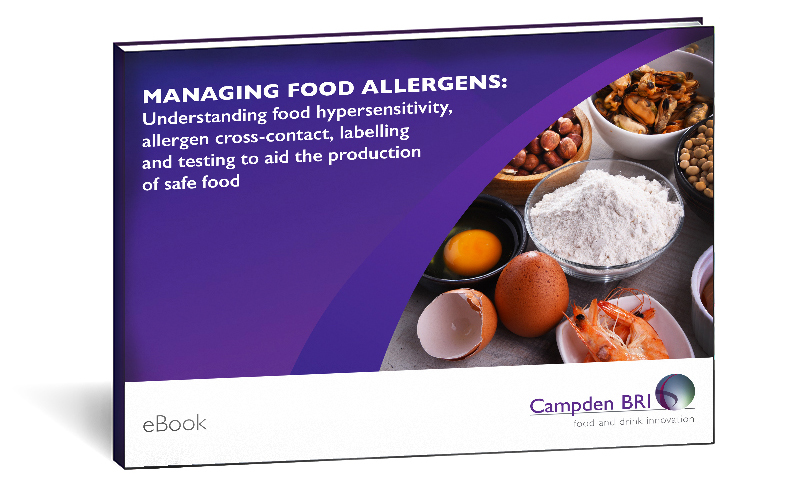
Allergen labelling
24 August 2023 | Helen Arrowsmith, Principal Food Law Adviser and Allergen Specialist
For information on food labelling, why not attend one of our labelling and legislation courses
A brief summary of the requirements for allergen labelling in the EU and UK
In harmonised EU legislation (the Food Information to Consumers Regulation (EU) No. 1169/2011 – FIC), which has been retained into UK law since EU exit at the end of 2020, there are 14 substances or products causing allergies or intolerances that must be labelled on food and drink packages if they have been deliberately included as an ingredient or are contained as part of a compound ingredient or processing aid that is deliberately added to a food. This requirement extends to all products and derivatives of these ingredients, with a few specific exceptions (listed later in this briefing). The requirement is laid down to make sure that the presence of the material or ingredient is clear to consumers.
Download our FREE Managing Food Allergens eBook today! Secure food safety, control and confidence through effective allergen management

Substances or products causing allergies or intolerances that must be labelled as listed in Annex II to the FIC:
- Cereals containing gluten, namely: wheat (such as spelt and khorasan wheat), rye, barley, oats or their hybridised strains*#
- Crustaceans*
- Eggs*
- Fish*#
- Peanuts*
- Soybeans*#
- Milk (including lactose)*#
- Nuts, i.e. almonds (Amygdalus communis L.), hazelnuts (Corylus avellana), walnuts (Juglans regia), cashews (Anacardium occidentale), pecan nuts (Carya illinoiesis (Wangenh.) K. Koch), Brazil nuts (Bertholletia excelsa), pistachio nuts (Pistacia vera), macadamia nuts and Queensland nuts (Macadamia ternifolia)*#
- Celery*
- Mustard*
- Sesame seeds*
- Sulphur dioxide and sulphites at concentrations of more than 10 mg/kg or 10 mg/l expressed as SO2 in products ready for consumption
- Lupin*
- Molluscs*
* and products thereof
# except exemptions
Allergen labelling requirements - The Food Information to Consumers Regulation
The Food Information to Consumers Regulation (EU) No. 1169/2011 details requirements for allergen labelling, among other labelling provisions. The Regulation states that for prepacked food, allergens must be emphasised in the ingredients list through a typeset that clearly distinguishes them from the rest of the ingredients. It is also stated that where several ingredients originate from a single allergenic source, the labelling must make it clear for each ingredient. Where foods are offered for sale without prepacking, the provision of allergen information is also mandatory but can be provided any way the business chooses including orally. It is a requirement under UK national law (The Food Information Regulations, 2014 - FIR) that if allergen information is provided orally, it must be indicated on a notice, menu, ticket or label that allergen information can be obtained by asking a member of staff. In the UK, an amendment to the FIR requires foods that are prepacked for direct sale (i.e. those foods prepacked prior to the consumer selecting or ordering them, and that have been packaged at the same place from where they are sold) are labelled with the legally compliant name of the food and a fully compliant ingredients list with the 14 allergens listed in the FIC (Annex II) emphasised, this legislation took effect from 1 October 2021.
Exemptions
Following extensive scientific evaluation, it has been agreed that some ingredients derived from an allergenic starting material are unlikely to trigger an allergic reaction in susceptible individuals under the proposed conditions of use and are therefore exempt from the requirement to label them as allergens. These are:
| Cereals |
|
| Fish |
|
| Soybeans |
|
| Milk |
|
| Nuts |
|
Gluten
It should be noted that gluten itself is not included in the list of substances or products causing allergies or intolerances that must be labelled. It is the cereal to which the legislation refers, as people can be allergic to proteins in these grains, including but not limited to gluten. The name of the cereals (e.g. wheat, rye, barley or oats) should therefore be emphasised in the ingredients list of products that contain them. Gluten can cause an autoimmune reaction in people with coeliac and related diseases; however, this is not a ‘true’ IgE mediated allergic reaction. The legislation does not therefore require the term ‘gluten’ to be emphasised. Please note that gluten-free foods and the limit of ≤ 20 mg/kg to make this claim refer to food suitable for people with coeliac disease (refer to Commission Implementing Regulation (EU) No. 828/2014 for details). We also have a blog specifically on this subject.
Allergen limits
The only allergen in the legislation with a ‘limit’ below which it does not need to be emphasised is sulphur dioxide and sulphites, which does not need to be emphasised if present below 10 mg/kg or 10 mg/L in the product ready for consumption. Therefore, unless an exempt derivative is being used, the allergens must always be emphasised in the ingredients list. The level of 20 mg/kg for making a gluten-free claim is not related to the allergen labelling requirement but is a level below which it is safe for the majority of people with coeliac disease to consume – see the section on gluten above, as well as our blog on cereals containing gluten.
Nuts and other allergens
The legislation lists the specific nuts that should be emphasised within the ingredient declaration. There are however, some other nuts and related ingredients to which people may be allergic, or which may result in allergic responses in nut allergy sufferers. Chestnuts and pine nuts, for example, are known to cause allergy in some people. In addition, there are other substances to which people are allergic but that are not included in the legislation, such as kiwi. Although these ingredients (as well as over 200 other foodstuffs) can cause allergic reactions, they must not be emphasised as allergens on the label of foods that contain them.
It is important to note that peanuts should not be labelled merely as nuts, but specifically as peanuts, as peanuts are legumes.
Precautionary ‘may contain’ allergen labelling
The above requirements relate only to ingredients that are part of the formulation of the food. They do not cover situations where there is a risk of cross-contact. Good Manufacturing Practices should eliminate or greatly reduce the risk of cross-contact in most cases.
Current recommendations are that precautionary allergen labelling should only be used where there is a realistic risk of cross-contact occurring that, because of the nature of the product and its production environment, cannot be eliminated. There is a lot of interest in this area, in which the industry is focussing its efforts to improve and structure how this is managed in practice. The Food Standards Agency (FSA) commissioned a review, under their Food Hypersensitivity programme, on the food allergen cleaning literature and guidance available internationally. We were selected to conduct the review, and our report – published 14 June 2023 – will support the FSA in determining how best to take allergen cleaning guidance development forward, which will support the PAL policy area.
Much work has been conducted on the use of quantitative risk assessment and the use of ‘action levels’ in determining the need for precautionary labelling, please contact us if you would like to discuss this.
We can help you with compliant food allergen labelling
For more information on common questions regarding labelling, see our white paper on Frequently answered questions about EU-harmonised and UK food law.
If you would like a full label review from our regulatory experts to check the compliance of your products across UK/EU and Global markets, get in touch with the Regulatory Affairs team (regulatoryadvice@campdenbri.co.uk).
Dealing with food allergens can be challenging – but our teams are here to help. We offer a range of services to support your food allergen management needs, including; testing, training, consultancy and support in food allergen management, labelling and legislation. These services can be customised to your requirements.
Alternatively, for more information on the topic areas above, and the many other necessary considerations when producing legally compliant products, check out our training courses.
For advice and further information on allergen labelling and other legislation issues: e-mail regulatoryadvice@campdenbri.co.uk.
For technical information on preventing and monitoring allergen cross-contact: e-mail support@campdenbri.co.uk
Allergen labelling white paper
Click below to download a copy of the white paper in PDF format
Managing Food Allergens eBook
Download our FREE Managing Food Allergens eBook today! Secure food safety, control and confidence through effective allergen management.






